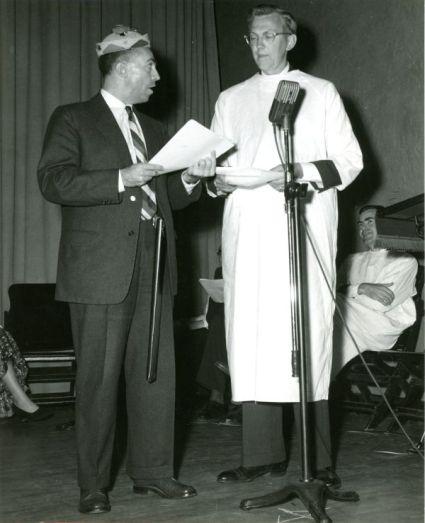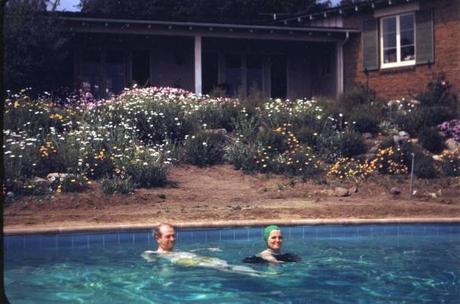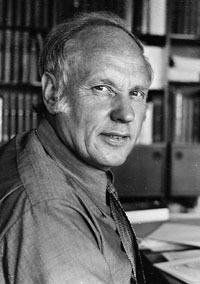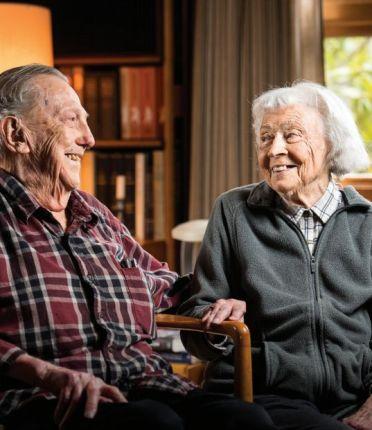
Ken Hedberg and others onstage at Caltech, performing in the celebration held for Linus Pauling on the occasion of his receipt of the Nobel Chemistry Prize, December 1954.
[A celebration of the life of Dr. Kenneth Hedberg, 1920-2019. This is part 2 of 5.]
Once enrolled as a graduate student at the California Institute of Technology, Hedberg worked under Linus Pauling and a fellow doctoral candidate, C. Gardner Swain, on a study of the oxidation of leuco malachite green to form a dye called malachite green. The group published a paper on the subject at the conclusion of Swain’s tenure as a student. It was unusual for a PhD candidate rather than a professor to supervise another doctoral student, but Pauling suggested the arrangement because the only professor doing the kind of work that Hedberg was interested in at the time – chemical kinetics and mechanisms – had died the year before and not yet been replaced.
Hedberg’s laboratory experience with Shell Development Company prepared him well for his studies, and proved especially useful to Swain, who had actually logged fewer lab hours than had Hedberg by that point. Ken also quickly discovered that the facilities at Caltech were not on the same level as those outfitted at Shell, and he soon realized that a major piece of his job would be to build basic instruments, an impediment that slowed progress significantly but was a simple fact of life in Pasadena (and that later came in very handy once Hedberg returned to Corvallis).
After Swain left, Hedberg began to work with a young faculty member, Verner Schomaker, who had also studied under Pauling. Together, Hedberg and Schomaker launched an investigation of the structure of boron compounds, starting with diborane, which they determined to have a non-ethane-like structure.

Ava Helen and Linus Pauling, 1948.
As one might expect, Hedberg came to know Pauling well and retained many fond memories of their interactions at Caltech. Later in life, he recalled that Pauling was friendly and generally well-liked but that he tended to maintain more formal relationships with his students and colleagues rather than embracing casual relationships. By Hedberg’s recollection, Pauling was always referred to as “Dr. Pauling,” even though most of his colleagues were on a first-name basis with one another. Pauling also rarely attended the frequent parties that were a mainstay for most others in the division.
Hedberg became trusted enough that he housesat for the Paulings several times and watched the Pauling children. He remembered in particular that Peter and Linda Pauling used to go around the chemistry department inviting everyone to come swim in the Pauling’s pool. The Pauling pool was a popular location, and was heavily used particularly when Dr. and Mrs. Pauling were out of town.
Pauling also sometimes let his childhood friend Lloyd Jeffress stay in the house if he was on holiday in the area while the Paulings were away. In one such instance, Pauling had asked Hedberg to stay at the house with the kids, and had also invited Jeffress to stay at the same time but had neglected to let Hedberg know. It took Ken three days to realize that Jeffress was also living in the house because their schedules were so different. Jeffress, on holiday, was waking up long after Hedberg had left the house in the morning, and was otherwise staying out late or staying in his room. With a laugh, Hedberg recalled waking up late at night two nights in a row thinking he heard someone splashing in the pool, but deciding not to investigate further once he had confirmed that the kids were in bed. He only realized Jeffress was there when he walked into the kitchen one day and saw a strange man making breakfast.
On another occasion, Hedberg was seated at his desk one Saturday morning when Pauling wandered into his office. Many of the Caltech graduate students were intimidated by Pauling, who often roamed the Gates and Crellin Laboratories in his slippers on Saturday mornings. In this instance Pauling sat down, put his feet up on Ken’s desk, and asked how things were going. Hedberg reported that all was well, and felt relieved when Pauling seemed about to leave without asking any probing questions.
Pauling then noticed a keychain on Hedberg’s desk, which he picked up and looked at. The keychain consisted of a device with an eyepiece and lens containing a small photograph which could only be viewed by looking into the eyepiece against a strong light. The image that one then saw was of a naked girl standing on a large rock in the middle of a mountain stream. Pauling peered through the eyepiece for a moment and uttered a response that Hedberg delighted in retelling. “Hmmm,” he said, “Basalt,” and then walked out of the office. Shocked, Hedberg had to look through the device himself to notice the rock.

Otto Bastiansen
Hedberg had initially planned to spend an extra year on his studies at Caltech before writing his thesis so that he would be able to work under Dr. Richard Badger, a renowned spectroscopist. Pauling suggested instead that Hedberg finish his thesis and get his degree, after which point he would make sure that Hedberg received a fellowship to stay on an extra year under Badger. Verner Schomaker was in Denmark at that time, supported by a Guggenheim Fellowship, so Hedberg’s work was actually being overseen by Robert Corey. He finished his degree and took his examination, and then found out that he had indeed been awarded a Noyes Fellowship to work with Badger for a year, learning spectroscopy and continuing his electron diffraction work.
At the end of the Noyes Fellowship year, Hedberg was appointed a research fellow at Caltech and worked on Schomaker’s grant through the Office of Naval Research. During this time, he met many researchers from abroad who came to collaborate with Pauling, and eventually he decided that he wanted to gain some international experience himself. In short order, he put in a Fulbright application to study spectroscopy in Belgium but was denied because his application missed the deadline. From there, Otto Bastiansen, a Norwegian scientist who had come to Caltech to work with Pauling and became good friends with Hedberg, suggested that Ken submit a new application for the following year to spend time in Bastiansen’s electron diffraction lab in Oslo. Hedberg did so and, at Pauling’s urging, he also submitted a Guggenheim application for Norway. As Ken later recalled,
…Pauling walked into my office and said to me ‘Well, are you getting ready to go to Norway?’… I said ‘I didn’t know I was going.’ And he said ‘Well, the selection committee generally follows my recommendations.’ And then he turned and walked out. That was the total conversation we had on the issue.
Shortly thereafter, Hedberg was informed that he had been awarded both a Fulbright and a Guggenheim fellowship to study in Norway. Meanwhile, Hedberg’s wife, who had initially planned to accompany him, dissolved their marriage shortly before they were scheduled to depart, so Ken went to Norway alone and with a considerable amount of funding in hand. Bastiansen met him upon his arrival, helped him find an apartment, and set him up with some recordings and a lesson book to help him learn the language. Ken’s Norwegian friends later came to be amused by him reciting his lessons to them because the way he talked reminded them of the rector of the university.
Ken made a very positive impression on his scientific colleagues as well. In 1954, after Hedberg left Norway, Bastiansen wrote to Pauling that
It was very nice to have [Ken] here, and I should like to take the opportunity both on behalf of the institute and myself to emphasize how much we appreciated having him working at our laboratory. We are very grateful that you made it possible for him to come here and that you let him stay so long. There have been many foreigners at our institute during the last years, but no one has been of such a great value for our team as Ken… He is now really a kind of key man in electron diffraction.

Ken and Lise Hedberg in 2018
Oslo was the setting for an important moment in Hedberg’s personal life as well. Once Ken had settled in, Bastiansen introduced Hedberg to his research assistant, Lise Smedvik. Her ability to speak English well, even though she had never been to an Anglophone country, immediately impressed Hedberg. Later he ran in to her by chance at a symphony and they went out for a snack together afterwards. More dates quickly followed.
In 1954, after a year in Norway, Hedberg’s fellowship was expired and he was obligated to return to the States. He and Lise had talked about getting married, but Hedberg had not felt ready because he was still reeling from the way his first marriage had ended. After arriving back in the U.S. he realized that he could not leave Lise behind, so he proposed to her. She accepted, and he returned to Norway that summer to be married. Their wedding took place in the Oslo City Hall and they remained together until Ken’s death earlier this year. Hedberg got along well with Lise’s family and remained deeply interested in Norwegian culture for the rest of his life. In time, he became fluent and literate in Norwegian and gave his lectures in Norwegian whenever he was invited to speak at a Norwegian university.
After they were married, Lise decided to move to the U.S. with her husband, but encountered difficulty in obtaining a visa. After weeks of waiting and not hearing back from the American embassy, Hedberg learned that they had not yet processed Lise’s application. He wrote a letter to his congressman complaining, but the congressman was dismissive and pointed out the embassy’s obligation to insure that this was not a marriage of convenience meant to get around U.S. immigration laws. Hedberg found out that the congressman was a conservative Republican and cited that experience as paramount in insuring his life-long allegiance to the Democratic party.
Once the couple finally obtained the necessary papers and moved back to the States, Lise almost immediately wanted to get right back on the plane and go home because she hated the smog that permeated the Los Angeles region at that time.
As it turned out, the Hedbergs stayed in Pasadena for more than five years, during which time Ken worked as a senior research fellow. One day a colleague in organic chemistry, Carl Niemann, stopped him in the hall to tell him that he had received a letter from an associate at Oregon State College regarding a position that had recently opened up in their Chemistry department. Niemann thought that Hedberg might be interested in this opportunity, on account of his Oregon State ties.
Back in 1952, prior to leaving for Norway, Hedberg had written to Pauling that he considered himself “a Californian in spirit” and expressed an interest in settling permanently in the state. But now things were different: Lise detested the southern California air pollution and she was also pregnant. The idea of raising a child in that environment was deeply off-putting, so Ken decided to explore the possibility of moving back to Oregon.
After investigating the OSC opportunity some more, Ken turned it down because he found out that the college was mostly looking for someone to supervise graduate teaching assistants and hold recitations for freshmen classes. It seemed unlikely to Hedberg that he would be able to get a good research program going in these circumstances, and he was not willing to give up his scholarly work.
Following Hedberg’s rebuff, OSC increased its salary offer in an effort to get him to come. But it was a conversation with Pauling that played a deciding role in Ken’s change of heart. Asked for his advice on the matter, Pauling admitted that “I think that Oregon State will not be a first class institution for research in my time and probably not in yours,” but he also offered that, “On the other hand that’s not really important… Lise will be very happy there, Oregon is a wonderful place to live… I think it might be worthwhile giving it a chance. I think you could make it go and you’d be very happy there.”
Thus encouraged, Hedberg decided to accept the position, and it turned out to be the right choice. Lise liked Oregon much better than dry, dusty California, because, as with Oslo, there were “trees in the forests and water in the rivers.” The couple made the move and so began a faculty career at Oregon State that lasted for sixty-three years.
